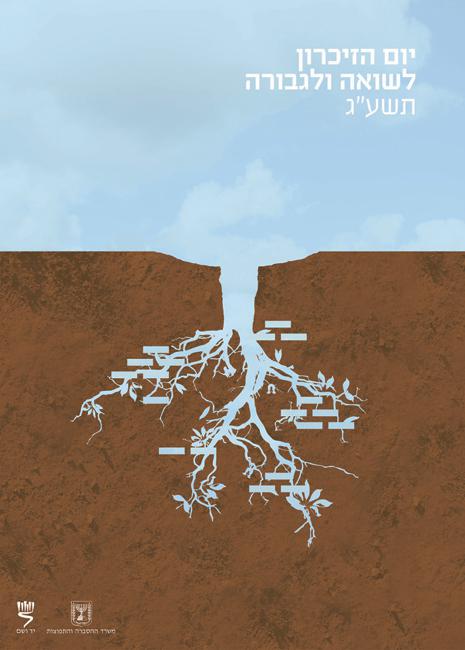The poster raises many questions that touch on the changes to the order of creation as we know it.
The tree in the poster has a trunk, branches, and leaves – in this way it is a regular tree. However it does not develop from any roots. It is not possible, as a result, to water it and it is not able to continue and grow. Its growth is backwards, down into the ground, in opposition to the order that one finds in the world, as if challenging the laws of nature. This departure from order is an analogy to the Shoah – when complete families, complete generations, were chopped down and began, at that moment, to grow in the opposite direction – from life on earth extending down into a reality of death below.
In our heritage, we compare the development of a person and their offspring to a tree. The growth of the tree represents life and continuity. The roots represent the base from which the tree grows - grandparents, mothers and fathers, the first generation. The fruit and leaves represent the children, subsequent generations. A well-known comparison of a person to a tree can be found in Psalms 1:3 “And he shall be like a tree planted by streams of water, that brings forth its fruit in the season, and whose leaf does not whither…”
And so, according to the concept presented in the poster, when so many families were destroyed during the Shoah (and for so many there was not a single remnant to continue the tree and its genealogy) the only feeling we are left with is upside-down trees. The future, that constitutes the original significance of the tree’s branches and leaves, has been lost, comes to nothing.
The poster makes no reference to survivors and their offspring. It does not concern itself with life after the Shoah and revival, but rather focuses on loss. There is in this a specific message that healing is not quick and it is not possible to reach complete renewal. Aharon Appelfeld, author and survivor, described this notion when he spoke about the cut that happened to the Jewish people after the Shoah. “After the Shoah, a third of the body that was the Jewish People was no longer alive. This is a biological wound in the family.” The reality of a physical wound, that can’t heal, and that carries the issue wherever it goes.
Inverted family trees still leave a chasm in the ground wherever they go. They are not seen, only by those who look for them under the ground. The poster demands of us, those who look at it, to also look at our world and see the trees that are buried around us, to examine and research them and maybe to even fill in names that are missing, each person according to his surroundings. This is the role of memory, in a partnership between the poster and the viewer the image is complete.







